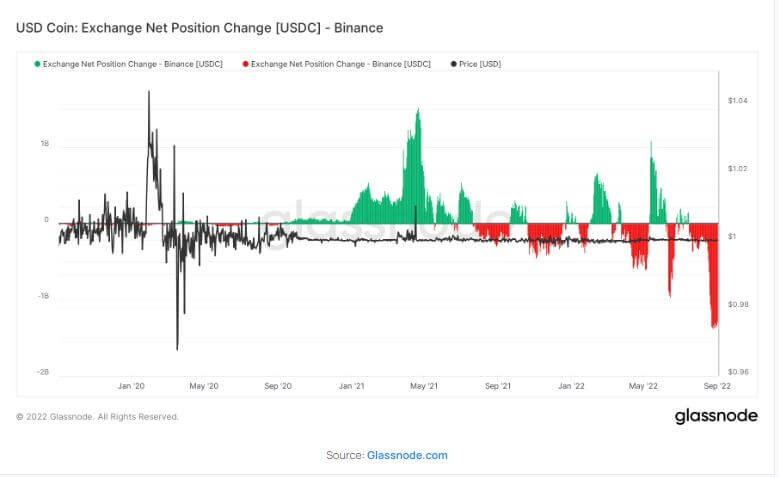1. Solana Wallet
Connect a Solana self-custody wallet (Phantom, Solflare or Torus).
Weekly recap of key Bitcoin metrics and the macro factors affecting its price performance in the market, published every Monday at 10:00 a.m. ET.

Cover art/illustration via CryptoSlate
When markets opened on the 29th of August, Fed Chair Powell provided most of the drama by saying that rates will continue to rise until inflation is brought under control. He pushed back on market expectations, which saw U.S. equities sink, short-term rates climb to their highest since mid-June and the two-year treasury yield hit its highest level since 2007.
The Fed was not the only central bank emphasizing its hawkishness. According to a Sept. 2 Reuters report, the ECB’s plan for a 75bps hike rate in its September meeting was backed by comments from Governing Council member Robert Holzmann, who said:
“50 basis points is the minimum for me… 75 basis points should be part of the debate.”
The comment sent the 2-year bund +35% higher.

House price gains are a thing of the past as the year-over-year rate of increase in the Case-Shiller house price index slowed to 18% in June from 19.9%. The decline is the largest percentage change since 2008.
However, more dynamic measures would show prices in decline. With mortgage rates almost 2x higher than a year ago and unsold inventory flooding the market, we should see a noticeable decline in September.
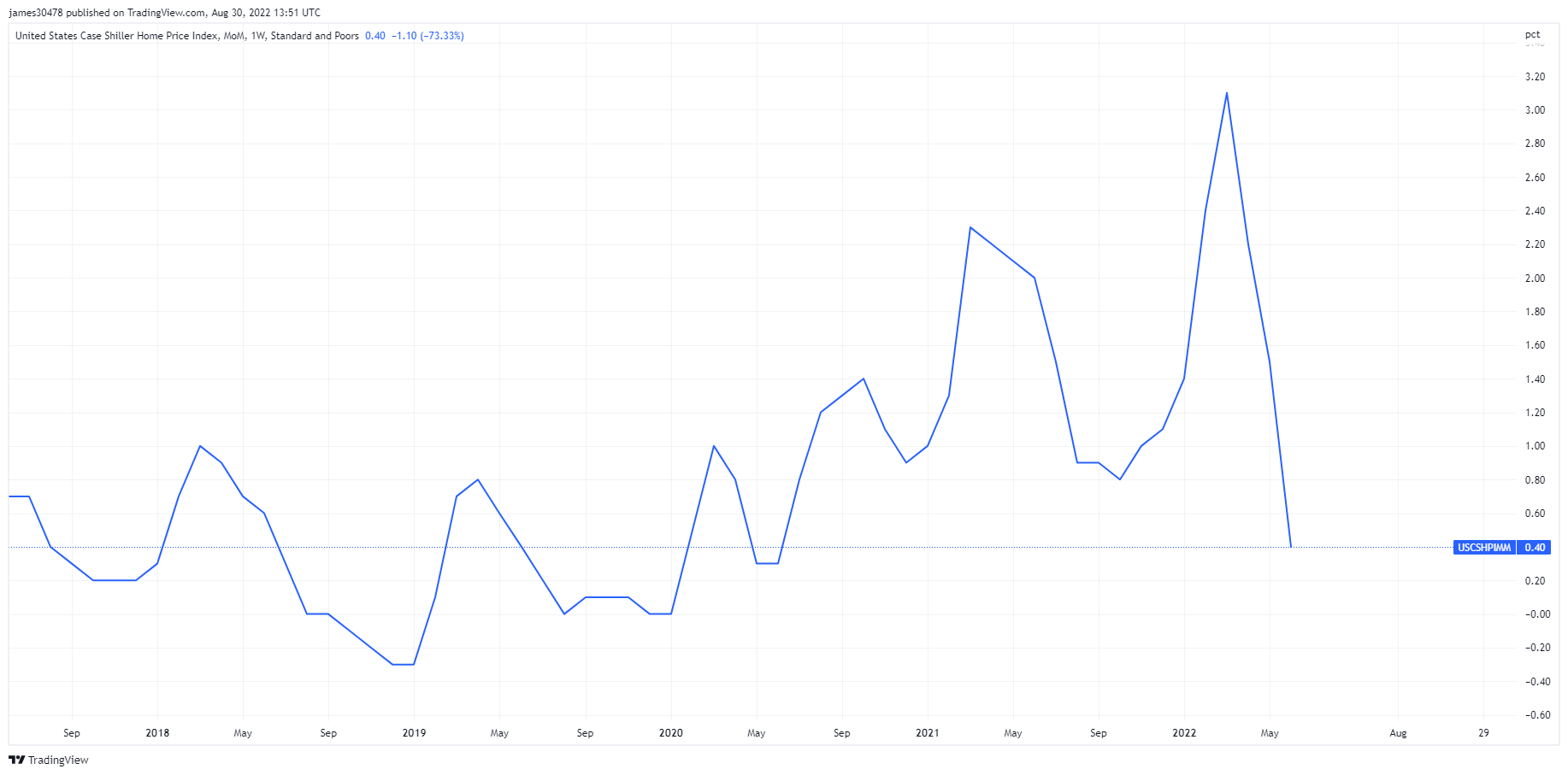
From Aug. 29 to Sept. 4, the DXY edged towards a two-decade high at 109.6. As the DXY strengthens risk assets will continue to perform poorly with a continued divergence between the DXY and BTC.
Another catalyst for a strong USD has been the emergence of weaker currencies. As you can see below USD against the EUR, GBP, and JPY are trending towards new lows.
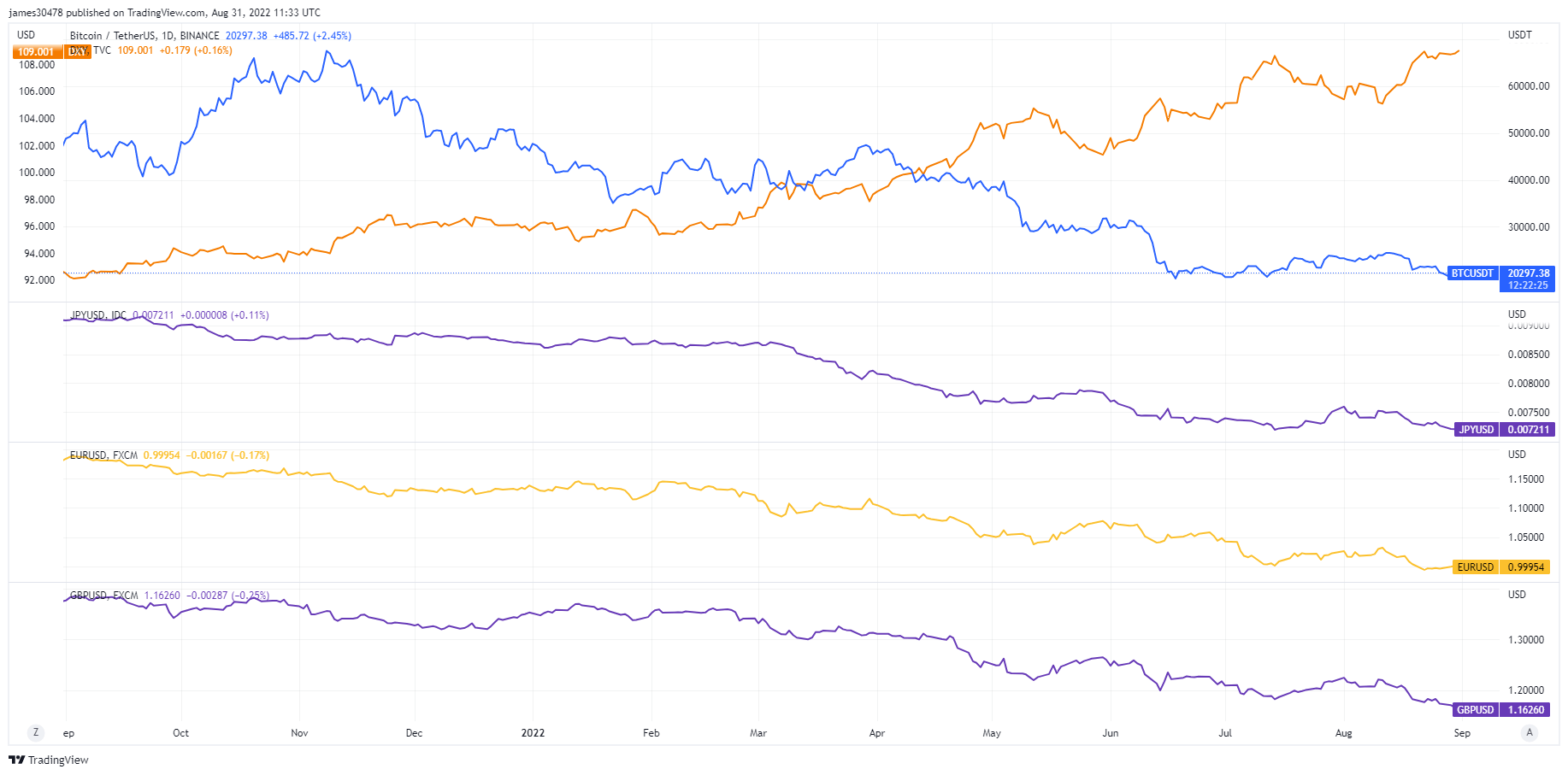
From the beginning of 2022, Bitcoin (BTC) and Ethereum (ETH) were joined at the hip in terms of price action; however, from mid to late June, ETH started to outperform BTC significantly due to the hype around the Merge.
A lot of speculators are heavily investing in the upcoming Merge through the derivatives avenue, which saw ETH almost hit $2,000 from a local bottom of roughly $900 in mid-June.
In mid-July, ETH futures volume stood at $23 billion and has since risen to over $32 billion, which contributed to ETH’s price discovery. We have highlighted in previous reports that the merge could be a “buy the rumor, sell the news” event.
BTC futures volume has significantly declined and spot price action has been stronger than futures (0.24) over the past 30 days — which is a much healthier sign for the Bitcoin ecosystem.
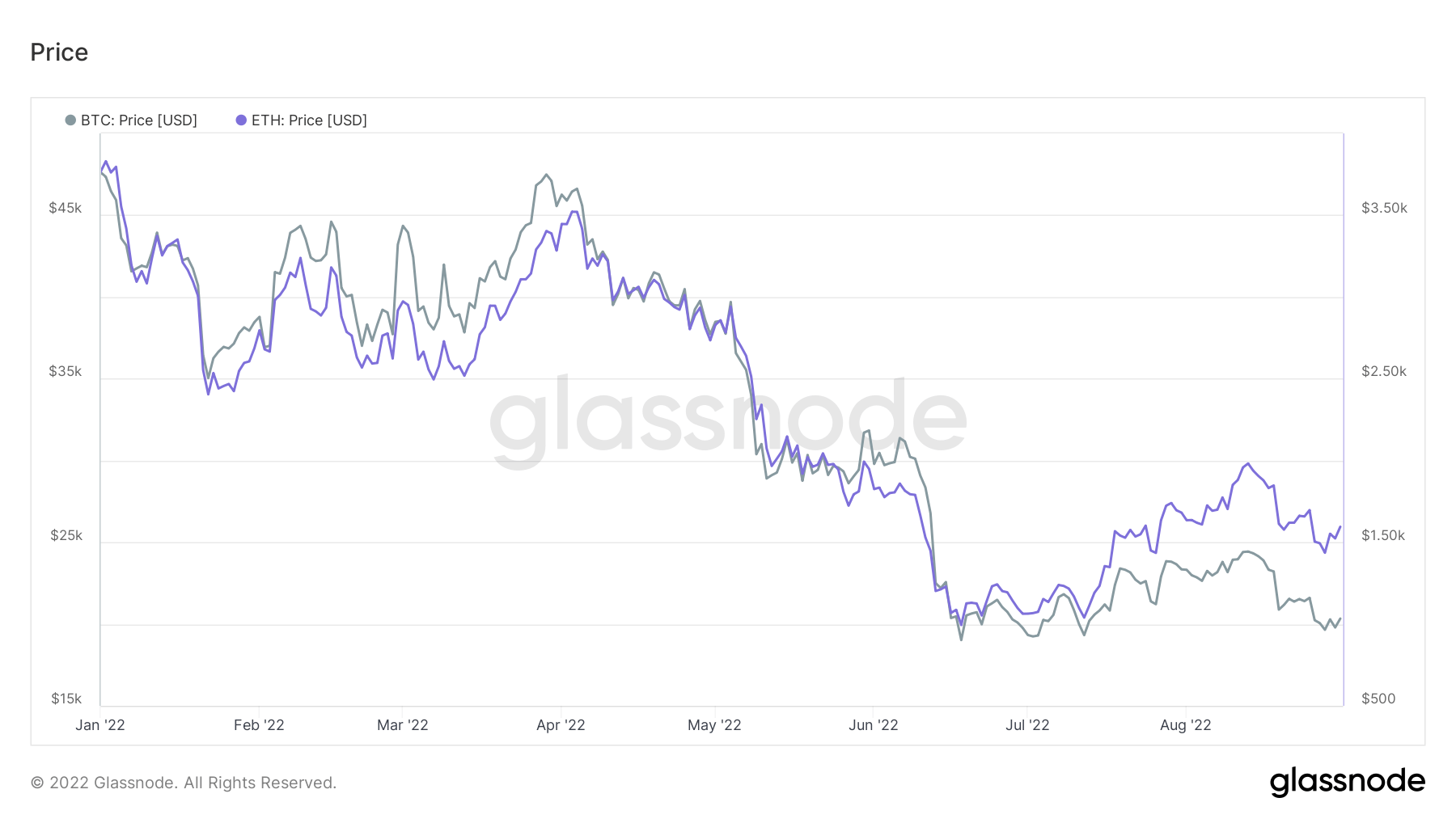
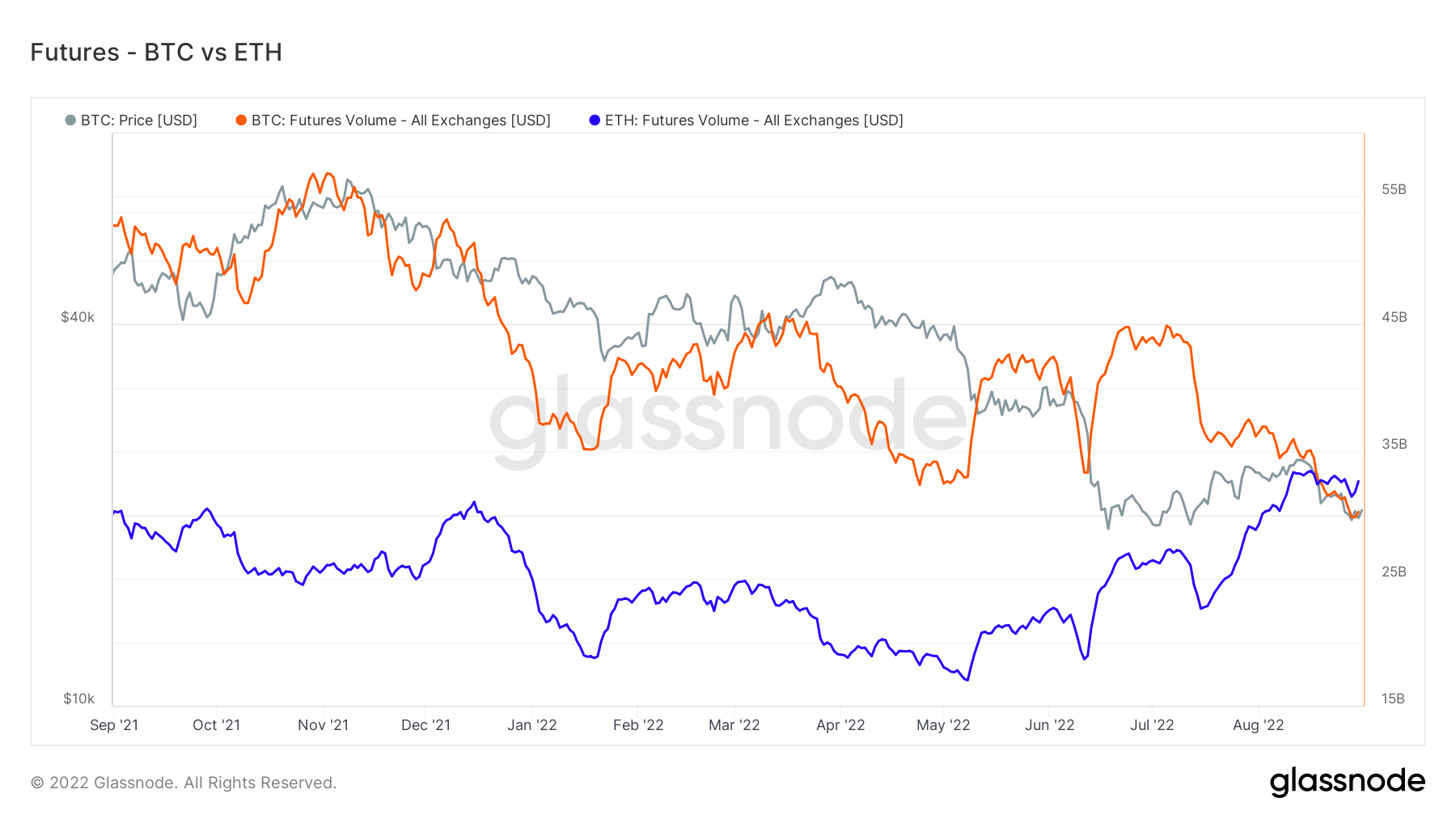
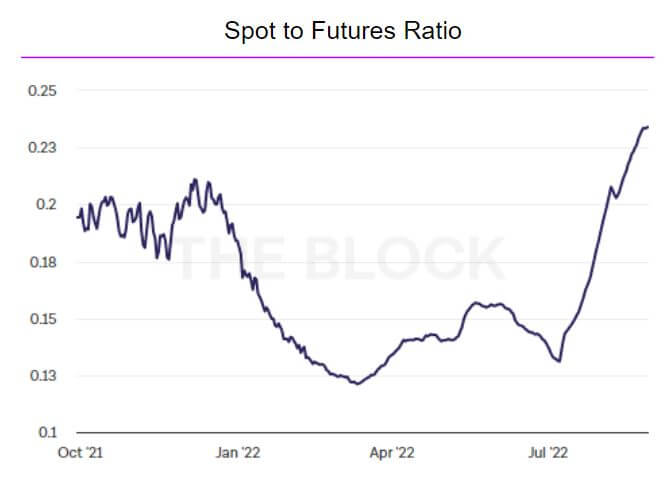
Equities have had a bad week since Aug. 29 due to supply chains breaking down, the cost of capital increasing and markets getting less efficient following the Jackson Hole meeting. Corporate profits are likely to suffer and equities likely to continue to perform poorly. Nasdaq is back in the bear market territory, down 20% from Aug. 1, while SPX is down 15% for the year. Markets have lost roughly 50% of the gains made during the summer rally.
We are now in a period of stagflation, low to zero growth, and high inflation — a similar situation to the 1970s, when equities were reasonably flat for the first 5 years between 1970 and 1975.
However, gold’s performance was exceptional, climbing over 350%. With Bitcoin considered digital gold 2.0 it may perform as gold did in the 1970s during this stagflationary environment.
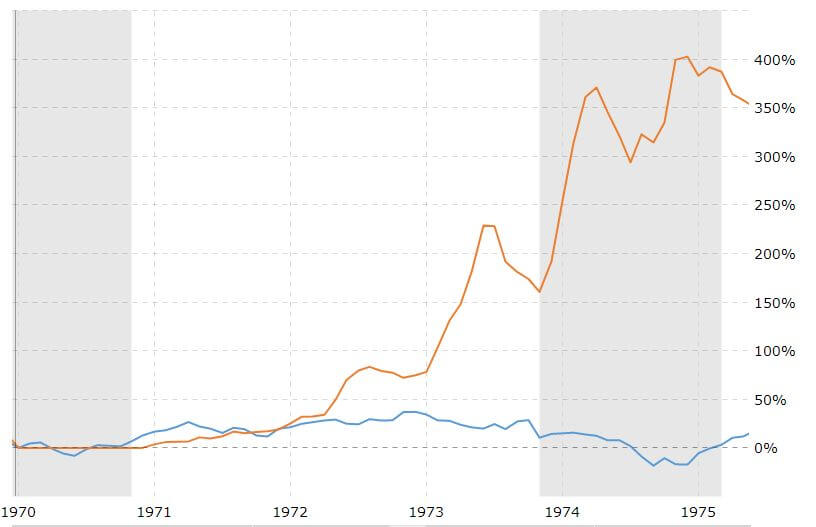
The major news in commodities comes from the energy futures market which is behaving like a meme stock and signaling that there might be trouble ahead. The eurozone is in a bit of a pickle, with record inflation, and a severely weakening currency but the triple threat is rising energy prices.
German Power 1 year ahead reached €1400 kWh, before drawing back down to just under €1,000, a 5x increase from January 2022. The futures market is signaling uncertainty and expecting the worst. When winter comes, rolling blackouts, factories shutting down and power shortages could become reality. Is the energy futures market perfectly reacting to a fear of collapse?
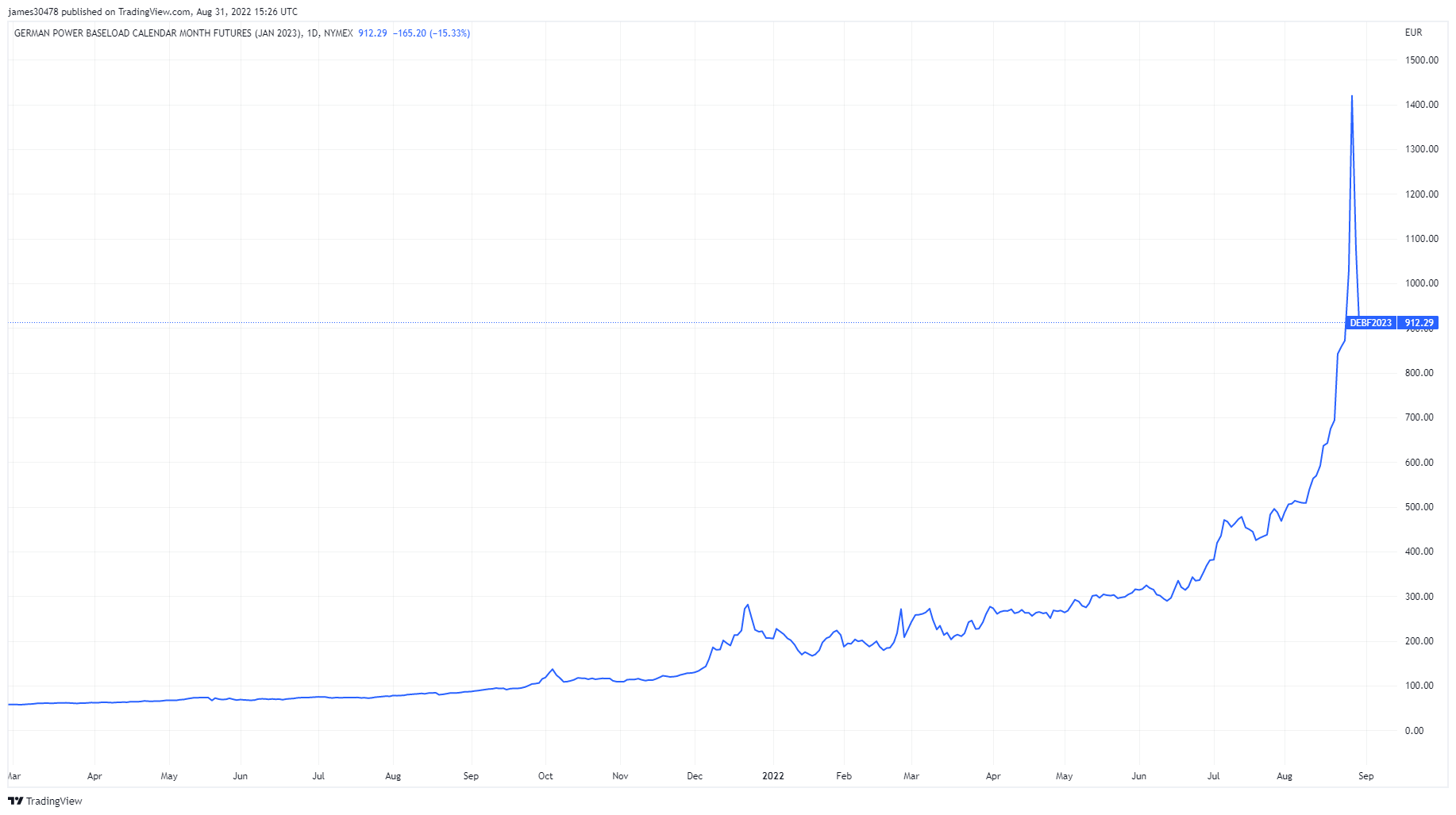
The stronger the dollar gets the more likely there will be a wave of defaults leading to a debt crisis. Gold is meant to be a haven asset but is trading down over 5% year-to-date and fell below $1,700 on Sept. 1.
BRICS countries — Brazil, Russia, India, China, and South Africa — have been accumulating gold. Russian President Vladimir Putin has been extremely vocal in recent months, about the money printing by Western countries and how it hurts emerging market countries as they export their inflation to the weaker countries, while becoming net importers.
China net imported 169 tonnes of gold in July. In recent history, this has only been exceeded by one month in 2018. This helps to explain the huge outflows from Comex. BRICS are buying all the gold and the West is selling it at a discount.

Crude Oil continues to plummet amid recession fears, implying that no asset is safe in this global deleveraging event.
The U.S. Dollar (DXY) is the world’s reserve currency. The DXY continues to set new highs and is crushing other market currencies.
The DXY is the primary unit of account for trade worldwide. It is a measure of strength against many other fiat currencies such as the euro, CHF, yen, and the British pound. The DXY is currently trading around 109.
One of the main reasons for the strength of the U.S. dollar is the flight to safety. As investors become concerned with the policies of foreign central banks, and underlying economic strength they chose to move into U.S. the dollar.
Additionally, we are seeing an increase in rate hikes by the federal reserve, setting its funds rate at 2.25% – 2.5% in July. We are witnessing the most aggressive one-year hawkish absolute change in the fed funds rate since records began, which shows the severity and quickness of these interest rate rises. The Federal Funds Rate is the interest rate banks charge each other to borrow or lend excess reserves overnight.
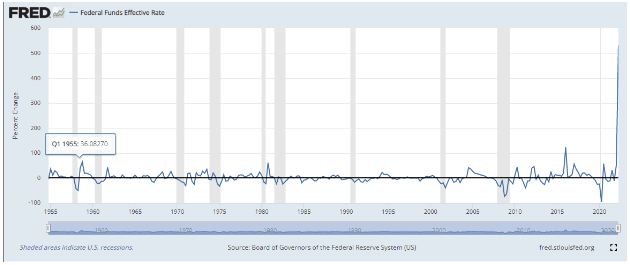
The last time the 2–year treasury yield was 3.5% was on Nov. 15, 2007. Comparatively, the percentage was 0.20% on Sept. 2, 2021.
The bond market is telling the federal reserve that there’s plenty of room to raise rates. The 2-year treasury is experiencing its biggest disconnect from Fed funds in many years. The Fed is expected to continue raising interest rates until a deleveraging event occurs. Most hiking cycles end in a deleveraging event, and since 1982, we have set a higher low with the fed funds rate.
Debt levels are historically high, and if the 2-year treasury is any indication, getting beyond 3% will be a struggle. Since 1988, every time Fed funds met the 2-year treasury, the watchdog ended rate hikes in the cycle.
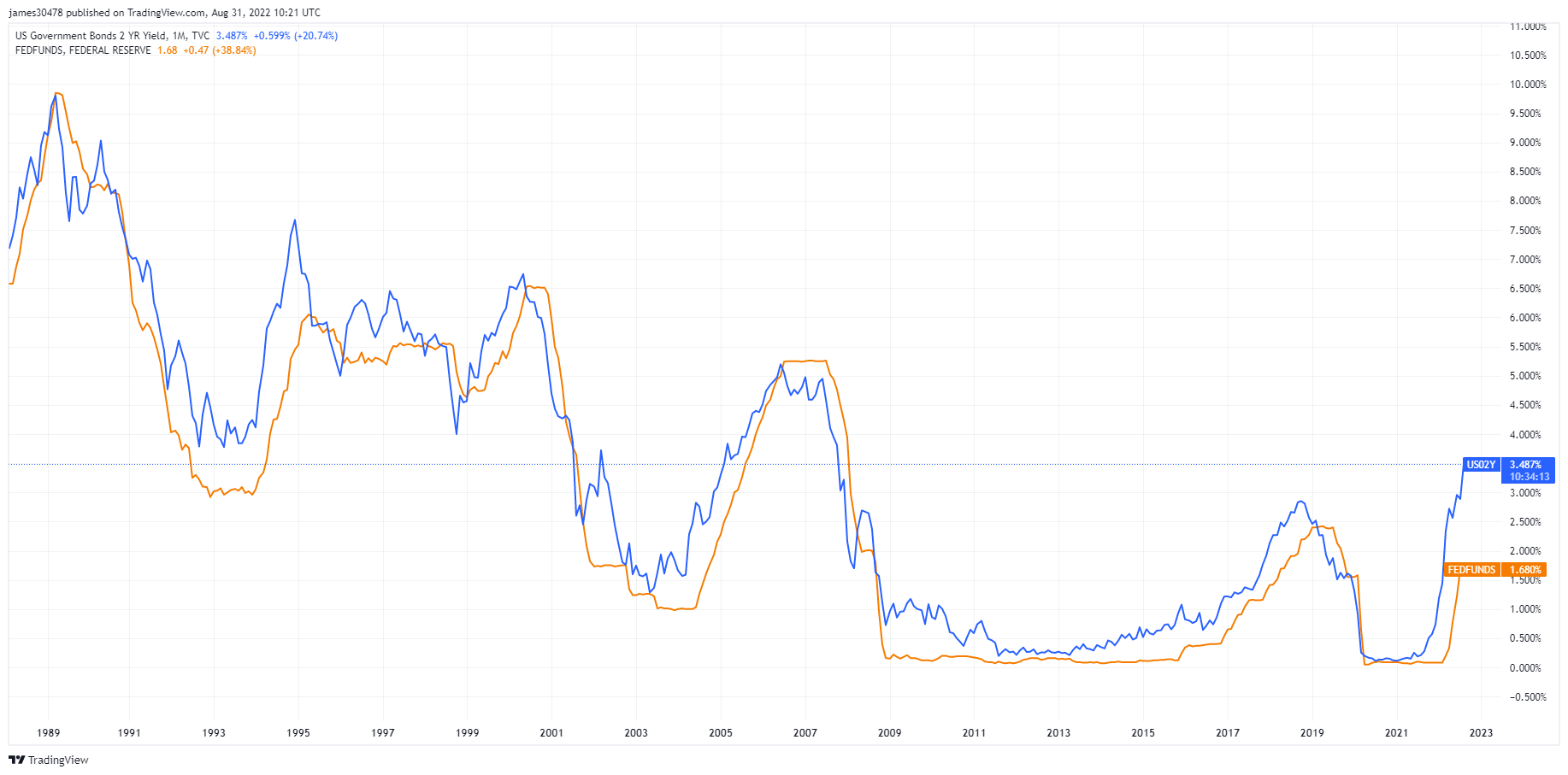
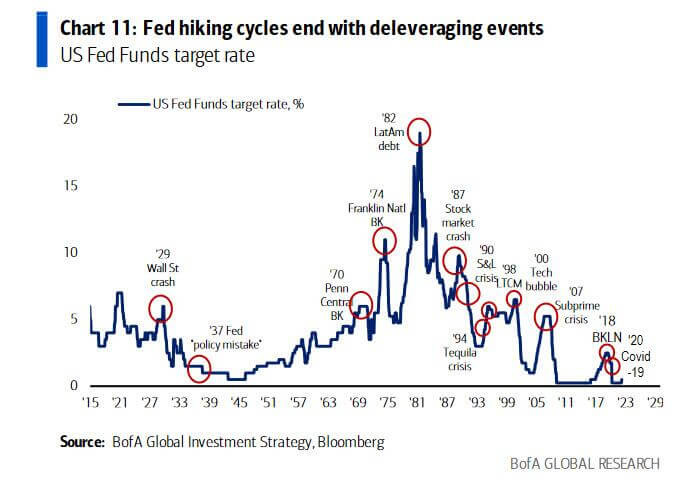

A rather muted week from an active and new addresses perspective suggested that not many new participants entered the ecosystem over the week. The muted week is most likely a consequence of Bitcoin being in the midst of a bear market and a significant deleveraging process going on in the macro. New and active addresses have stayed rather flat which encompasses the broader trends of the year as well. One of the bright sparks this year were addressees with a non-zero balance accumulating at an extremely aggressive rate but that has tapered off in recent weeks.
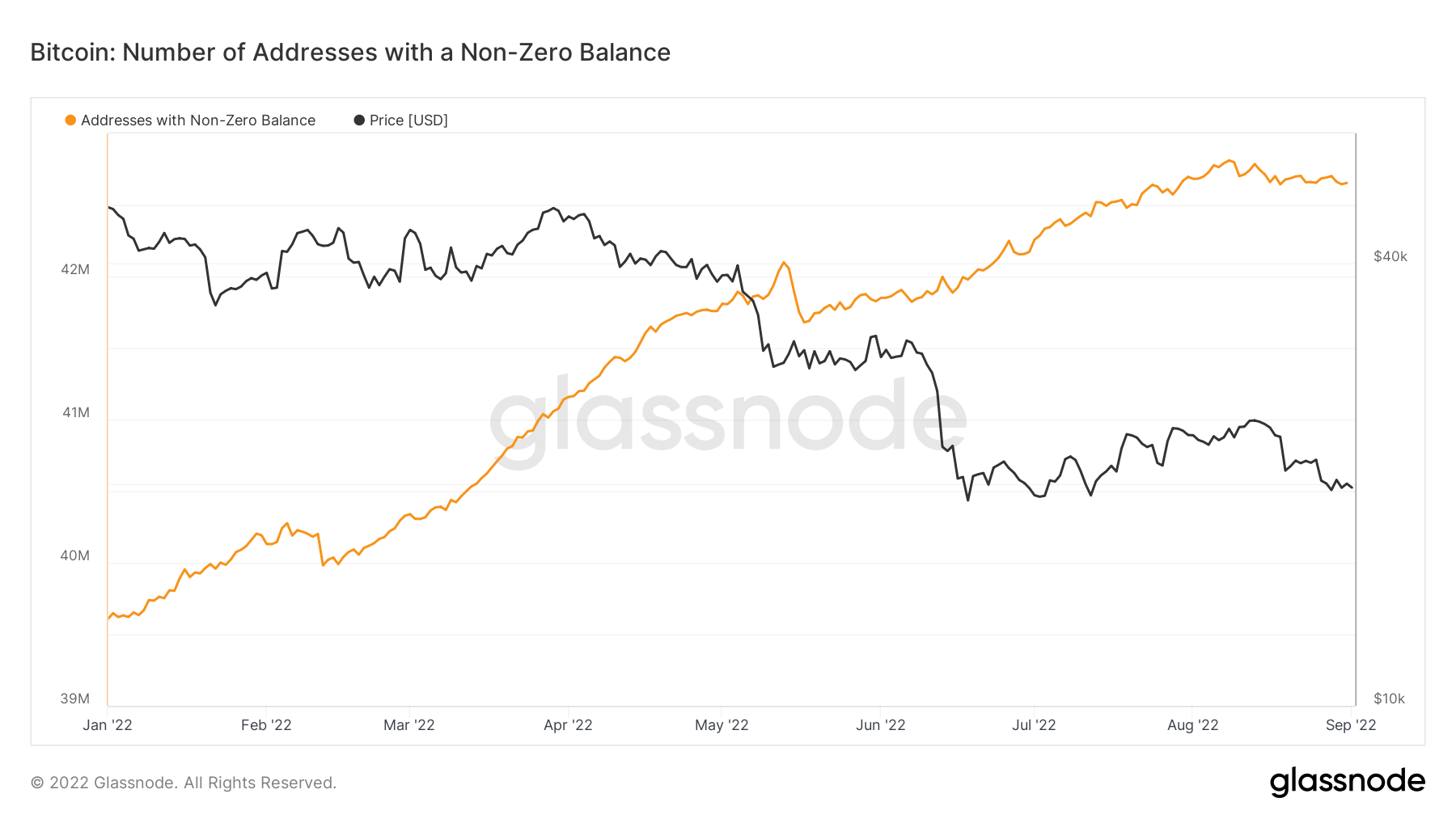
The percentage of unique addresses whose funds have an average buy price that is lower than the current price. “Buy price” is here defined as the price at the time coins were transferred into an address. Every bear market cycle has seen addresses in profit drop below 50%, but we have generated a higher high after each cycle. Is this time different, or do we go lower? During the bear market lows;
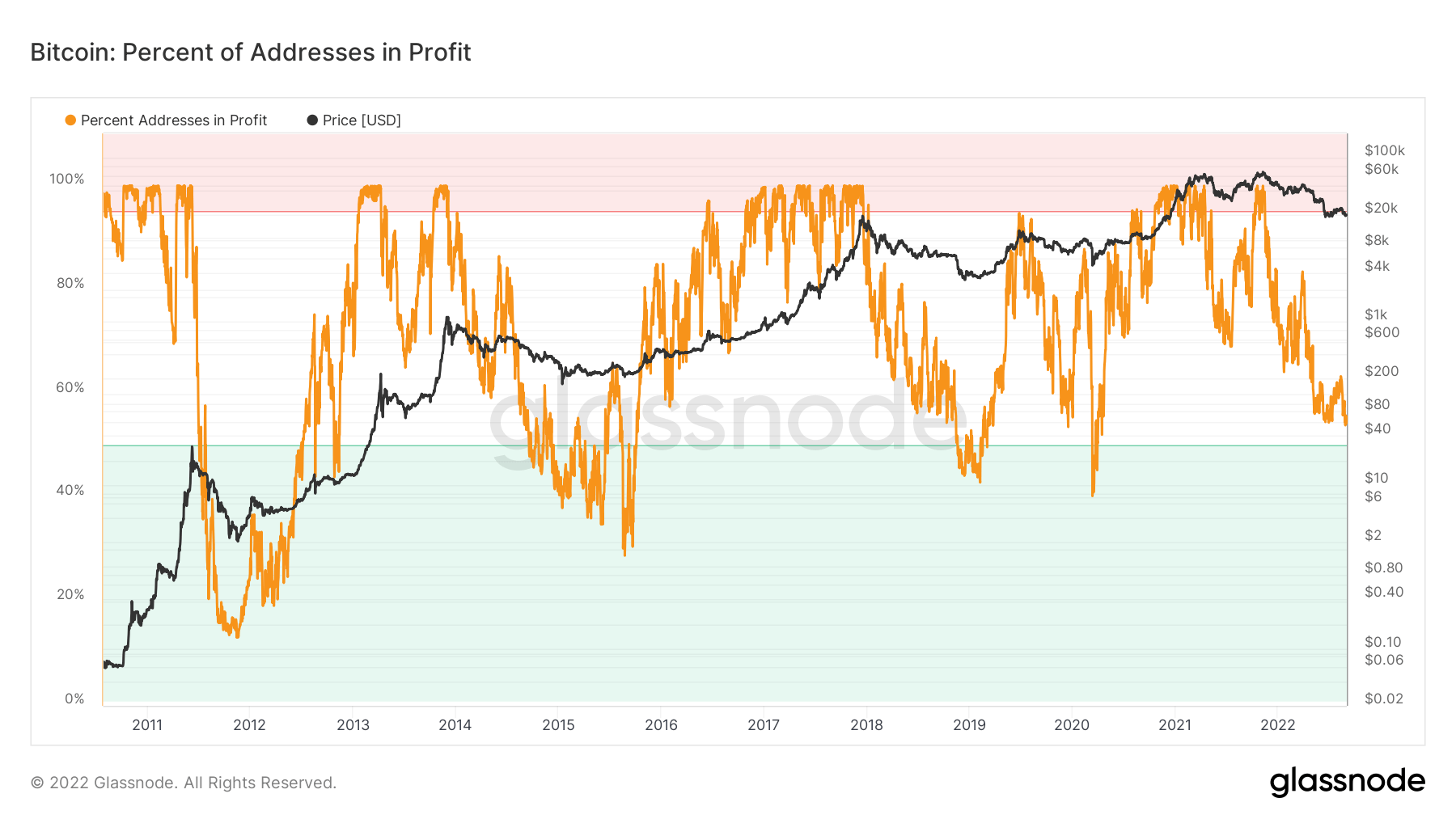
Active and new entities as a whole behave very similarly to addresses, it’s showing signs of a fundamental weakness in the ecosystem. The active entity is a good gauge to understand the daily users of Bitcoin, for the past few weeks we have been in this stagnant period, if Bitcoin were to fall further it would show severe weakness in user adoption. Most interestingly, in each bear market cycle, Bitcoin continues to put in a higher high of active users, which demonstrates more entities coming into the network and staying.

Shrimps have been one of the most refreshing entities in the ecosystem for Bitcoin this year, their rate of growth has been nothing short of remarkable. Shrimps are defined as holding one or less Bitcoin, not only has this group seen exponential growth in terms of stacking Bitcoin but 2022 has been the year which has seen the greatest net position change surpassing 2017. Even with all the fear, uncertainty and doubt, they continue to accumulate and hold. It will be interesting to keep an eye on the shrimps with a recession on the horizon, Bitcoin is the most liquid asset to sell to pay off your fiat obligations.
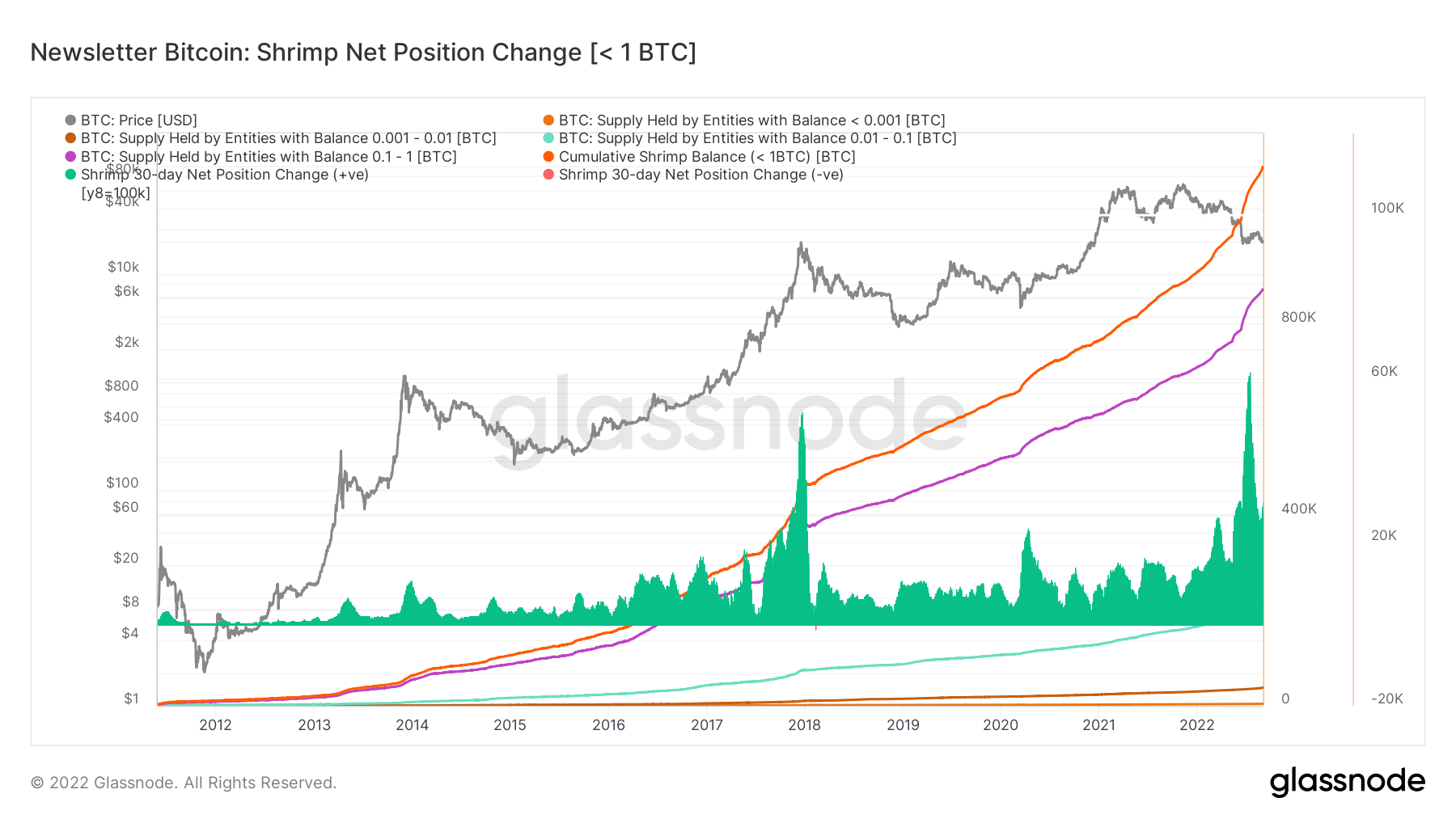
Derivatives this week have been extremely eventful, we have seen a relentless amount of shorts in the futures perpetual funding rate, not seen since the lows in mid-June. Remember, the average funding rate (in %) is set by exchanges for perpetual futures contracts. When the rate is positive, long positions periodically pay short positions. Conversely, when the rate is negative, short positions periodically pay long positions. This is one of the metrics CryptoSlate looking for to confirm a cycle bottom, each cycle’s bottom is when shorts are relentless and bold.

CryptoSlate is also seeing a lot more risk being taken which can be considered a good thing as there is a lot of cash sitting on the sidelines. Crypto-Margin Futures Open Interest is at similar levels to May 2021 of around 210 thousand BTC being used as collateral and has been working its way higher since the March bottom. This metric is defined as the total amount of futures contracts open interest that is margined in the native coin (e.g. BTC) and not in USD or stablecoin.
This also coincides with the most amount of leverage in the system, a significant uptick in Futures Estimated Leverage Ratio (ELR) in August. The ELR acts as an Indicator that measures the ratio between open contracts awaiting execution and the reserve of currencies on futures trading platforms. The graph shows the ELR has reached an all-time high of 0.32 — indicating the potential for high volatility should there be large price swings.
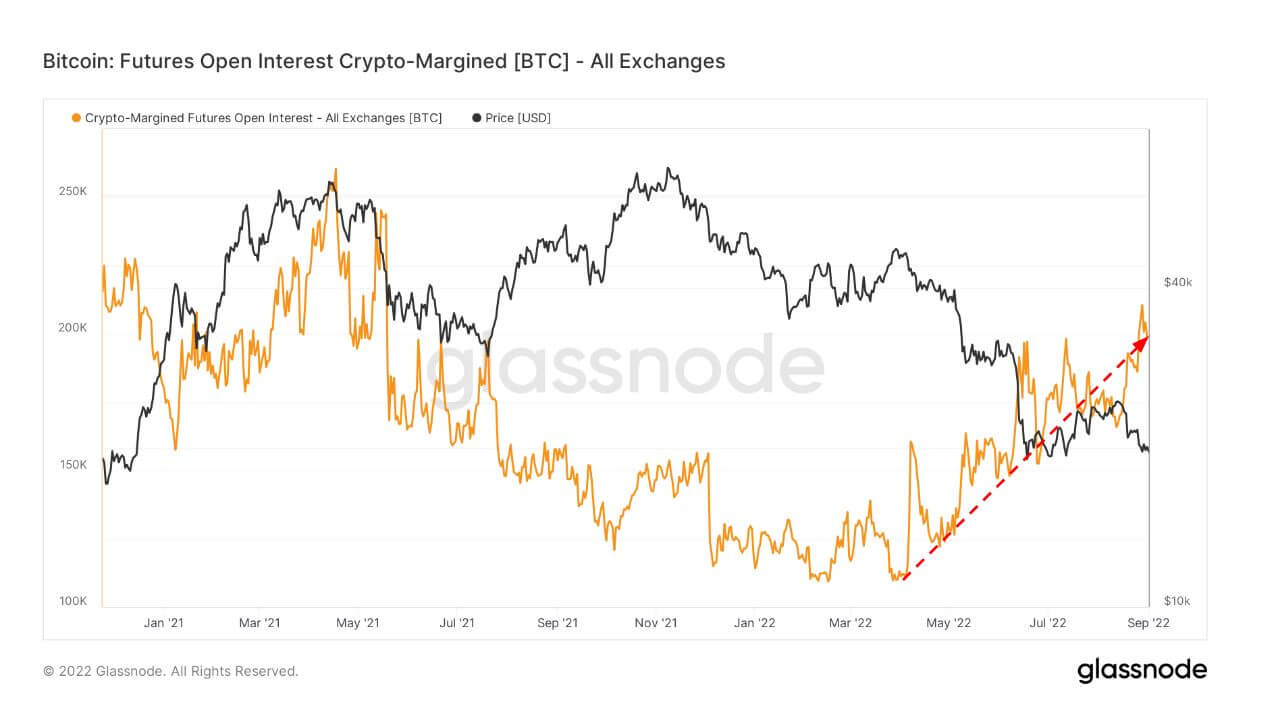

Bitcoin mining difficulty increased this week by over 9% the biggest increase since January of this year, and is less than 1% away from its all time high. As hash price (miner revenue/TH) is approaching all time lows, as is normal in Bitcoin bear markets. Miner margins continue to squeeze, which is likely to result in narrower profit margins for the industry.

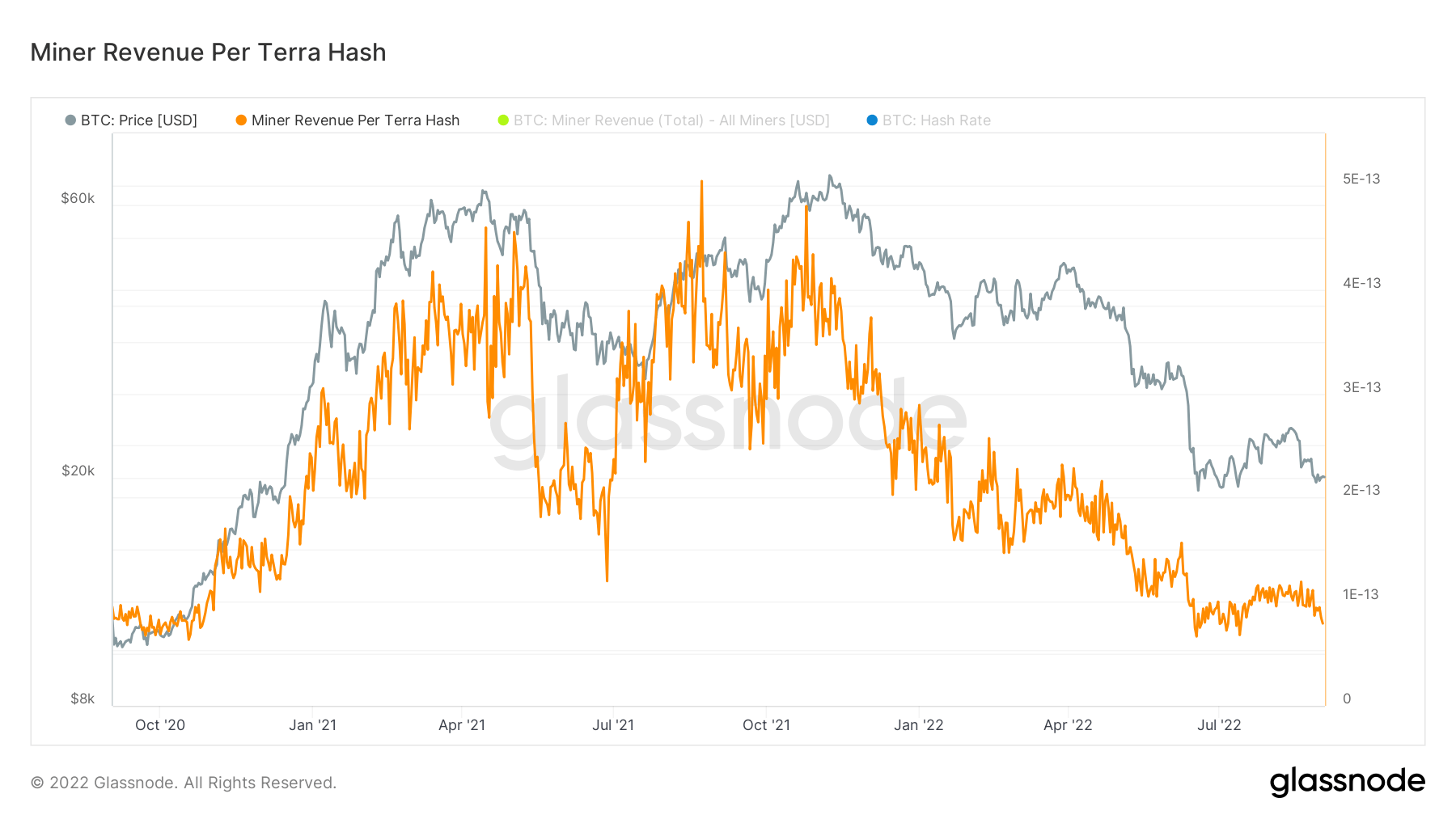
During the 2018 bear market cycle, CryptoSlate can observe from the metric, Exchange Net Position Change a lot of inflows and deposits occurred including the cycle bottom. However, during this past week, demand has been extremely strong. Over $1 billion worth of Bitcoin has been withdrawn each day, which shows the appetite investors still seem to have. However, compared to the 2018 bear market cycle, saw an overwhelming amount of Bitcoin put back onto exchanges up over $3 billion leading up to the 2017 bull run peak.
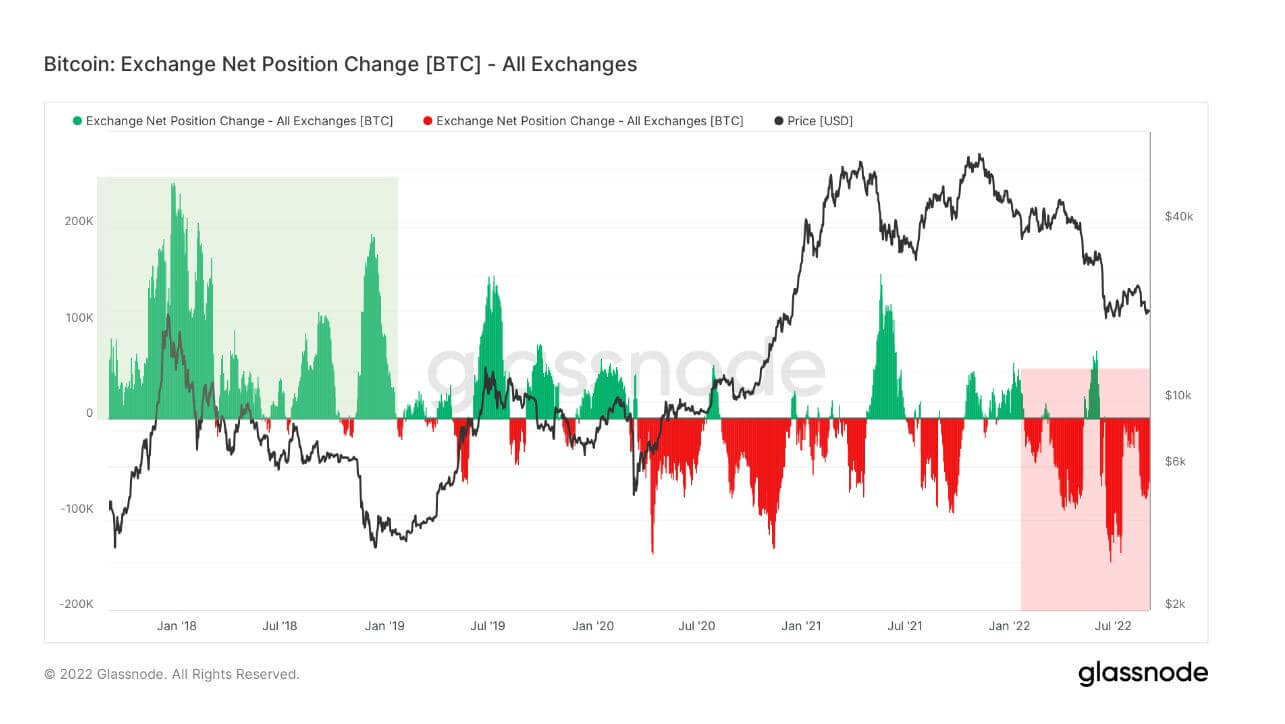
In recent weeks, outflows of BTC have occurred from FTX, which sees only 17 thousand BTC left on exchanges but starting the year with over 80 thousand BTC. Coinbase has also seen over 155 thousand BTC being pulled from exchanges this year, these are bullish long-term trends.
![Bitcoin: Balances on Exchanges [BTC]](https://cryptoslate.com/wp-content/uploads/2022/09/ftx.png)
A lot of uncertainty is occurring in all markets and regions right now, and something we have alluded to in previous articles is Asia continuing to be the smart money, buying when prices are low and selling high. This week that trend continues, albeit reserved accumulation from Asia.
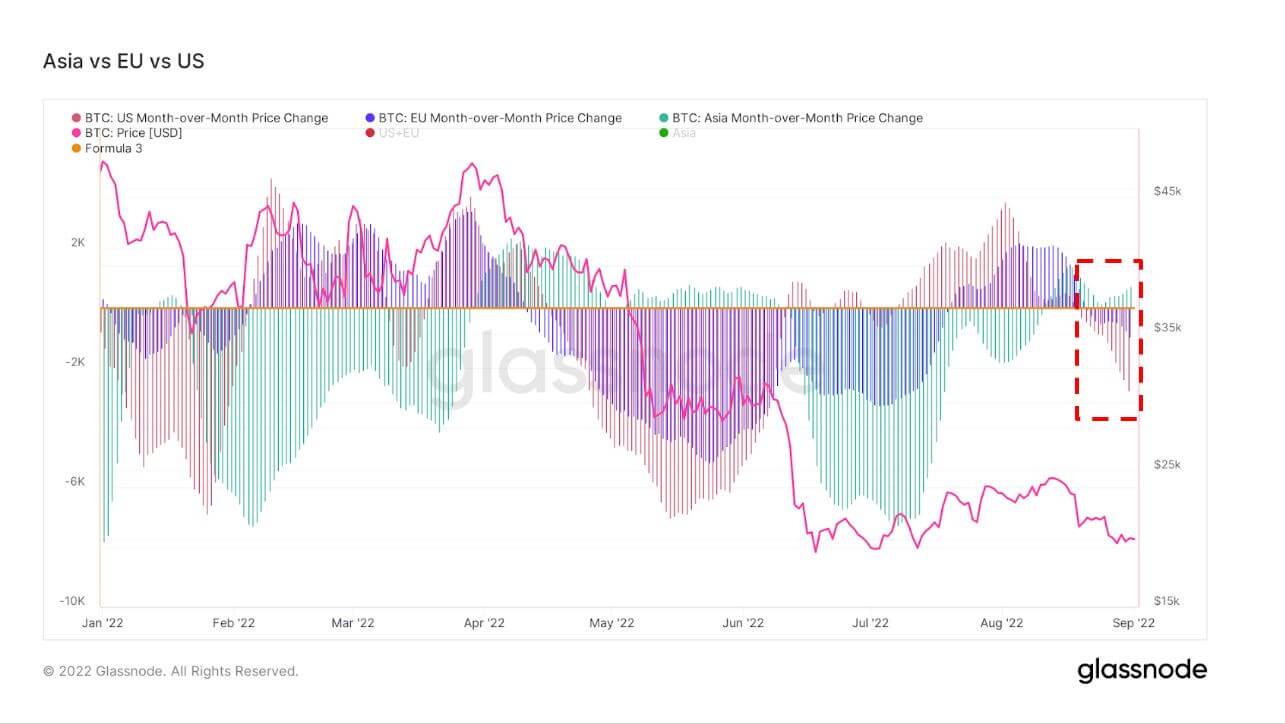
A new metric Glassnode released is the Year-over-Year Supply Change which aims to give an estimate for the year-over-year change in the share of the Bitcoin supply to be held/traded in Asia.
During the late 2021 bull run supply went negative (highlighted in red) and dropped as low as -4%. However, since the turn of the year, their share of supply has only grown due to suppressed prices being an opportunity to accumulate.
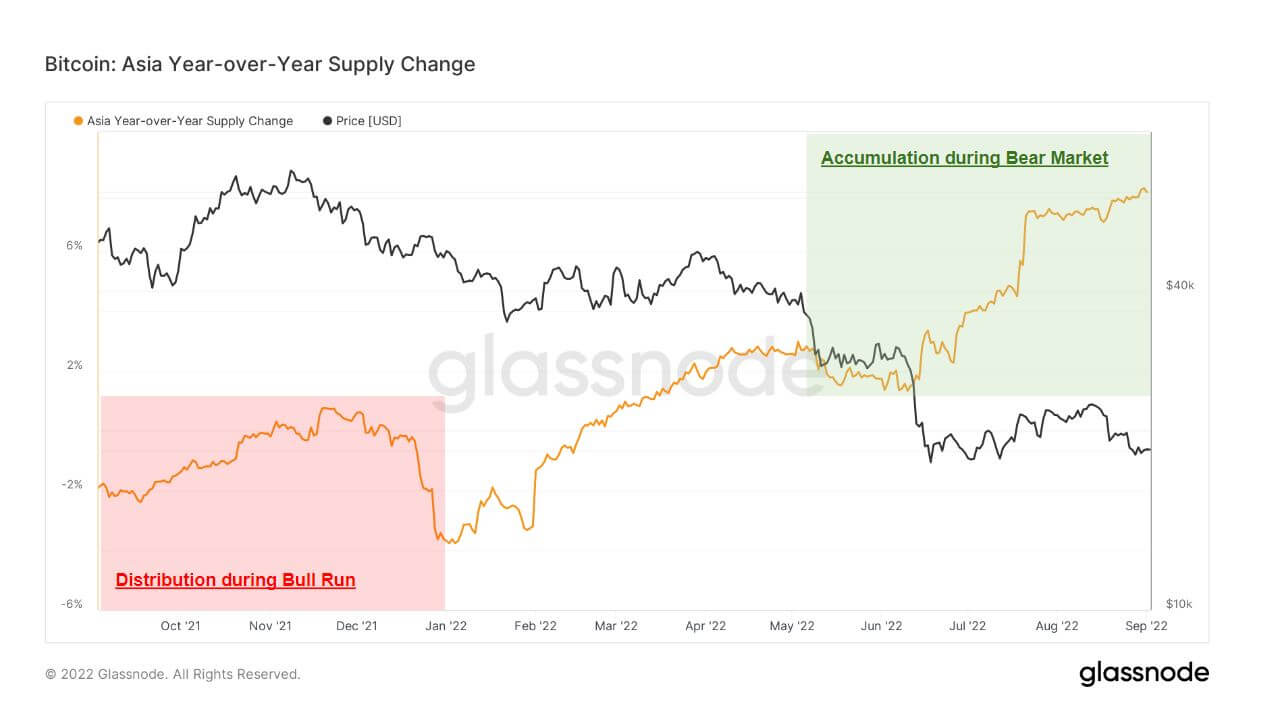
Lightning Network capacity in terms of Bitcoin adoption continues to increase and set a new all-time high of 4,631 BTC — a 4x growth in two years as capacity was roughly 1,000 BTC on Sept. 2, 2020.

Long-term holders (LTHs) have been increasing their holdings and hold an estimated 13.5 million BTC as of Sept. 5.. LTHs capitulated after the LUNA collapse but have now started to accumulate again.
in previous cycles LTHs bought when prices were suppressed and sold in the bull run, while short-term holders (STH) did the opposite. Data shows the same divergence is playing out again, with LTHs accumulating and STHs supply decreasing.

UTXO Realized Price Distribution (URPD) shows at which prices the current set of Bitcoin UTXOs were created, i.e. each bar shows the number of existing bitcoins that last moved within that specified price bucket.
Volume was very low when markets hit the $25,000 local resistance during the August rally. In addition, volume was also low when BTC fell to its June low of $17,600. URPD can be treated like a volume profile, with all the volume concentrated between these two areas which have been sucked up by short-term holders.
As time passes by we hope to see this volume change from STHs to LTHs and an increase in volume at these lower bound areas.

Accumulation Trend Score by Cohort breaks down the Accumulation Trend Score into the relative behaviour of various wallet cohorts.
The relative strength of the accumulation for each entity’s balance size is measured by both the size of the cohort, and the number of coins they have acquired over the last 15 days.
Entities that have 10 thousand BTC or more have been distributing BTC at an aggressive rate, showing that whales have slowed their Bitcoin accumulation this month as they are in deep red, meaning they are massively net selling.
Other cohorts seem to be meandering around 0.5 which shows the uncertainty in the market, with investors unsure of accumulating or distributing.
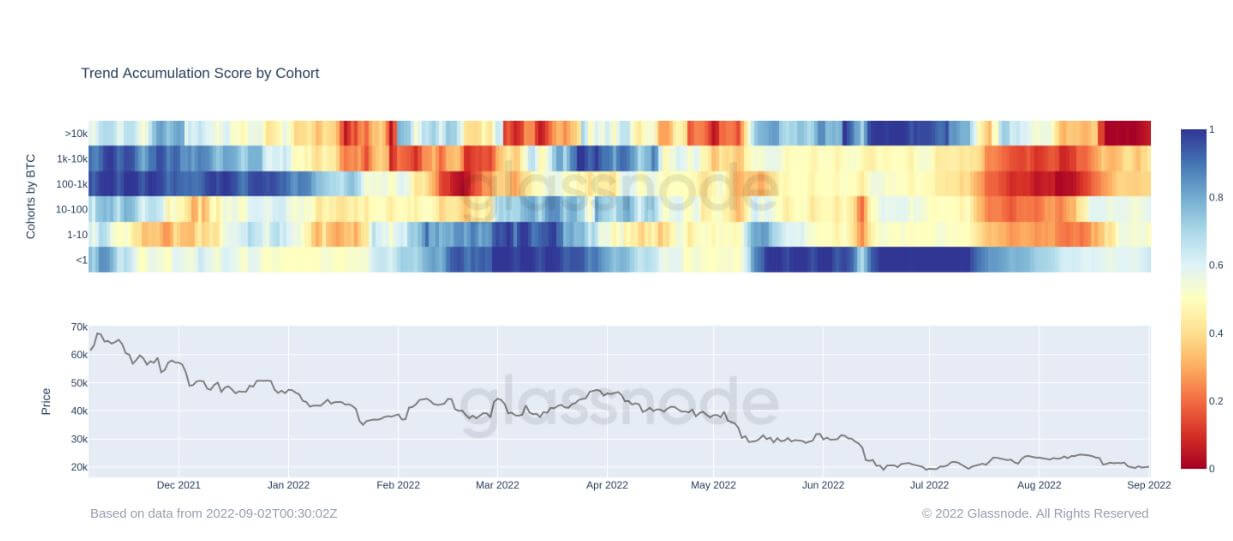
An interesting transaction occurred this week, with 7-10-year-old coins being spent almost 0.5% of the supply (roughly 5 thousand BTC), the second biggest spending from this cohort for over a year and a half. The last time this cohort spent big was in April at the peak price of $48,000 just before the Luna collapse.
These “OG Whales” have gained much experience and tend to sell or de-risk before major downsides. This cohort has seen many a “FUD”, multiple drawdowns, and fork wars. As we alluded to before, similar movements have not been good for Bitcoin’s price which is why whales are considered smart money.
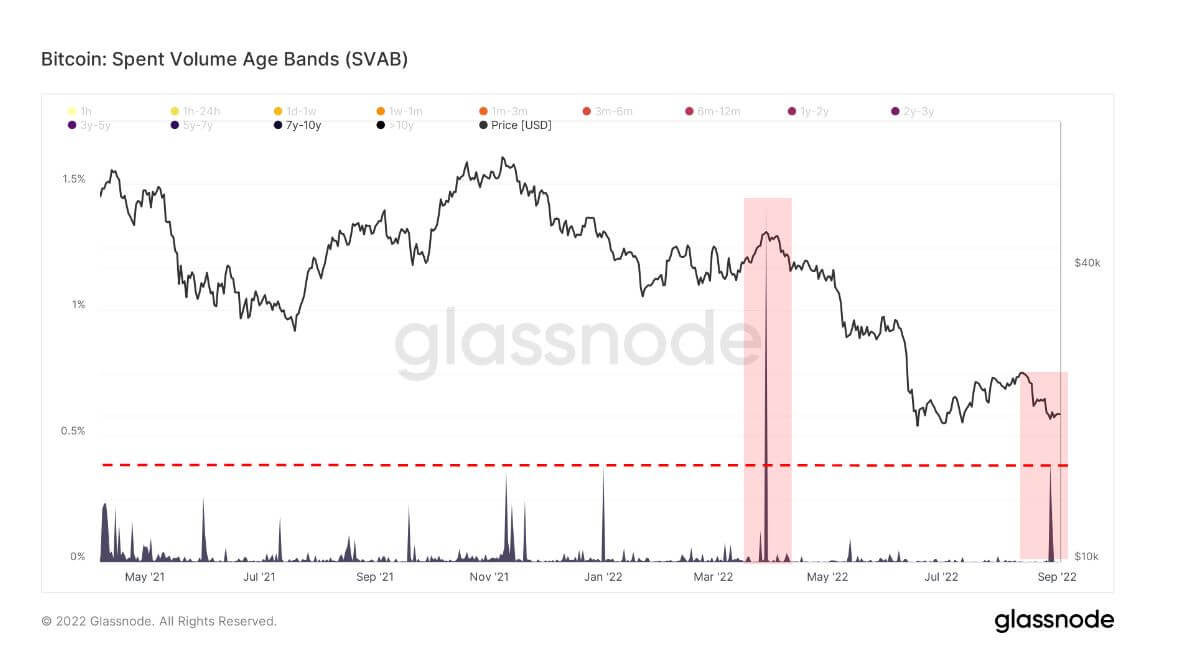
With over $40 billion in stablecoin sitting on exchanges waiting to be spent, a recovery could potentially materialize quickly in BTC. While billions in value available in stablecoin can be viewed as bullish for the entire crypto market — it does not mean that this value will flow directly back into BTC when the market goes risk-on again.
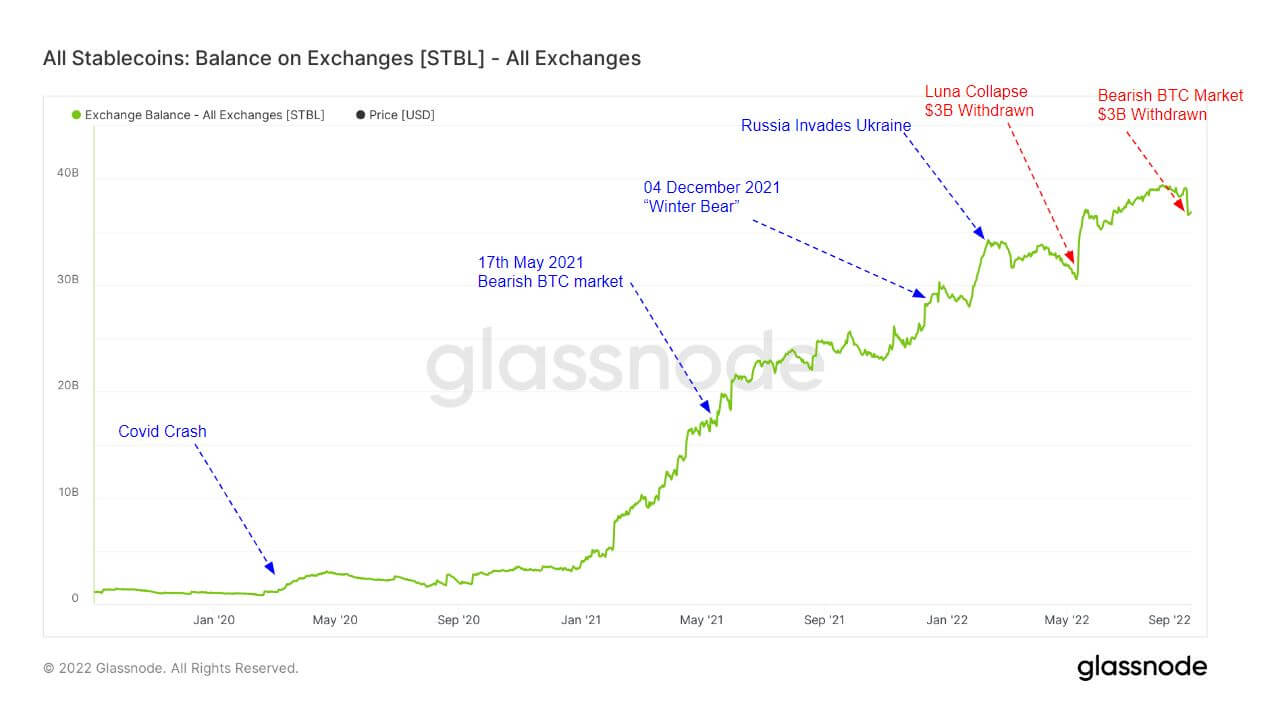
(*The chart above only accounts for the following Stablecoins: BUSD, GUSD, HSUD, DAI, USDP, EURS, SAI, sUSD, USDT, USDC)
More than $3 billion in stablecoins was withdrawn from the balance on exchanges which is a considerable amount. The last time such an event occurred was during the collapse. Further analysis reveals that over $1 billion USDC left Binance hot wallets per day this week.
